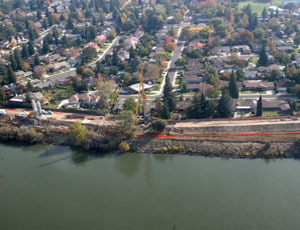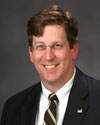Shifting the emphasis of flood risk reduction work from structural, to non-structural efforts, such as better risk communications and improved evacuation planning, is a key recommendation the National Committee on Levee Safety will make in a report to Congress on Jan. 15.

The levee failures in New Orleans after Hurricane Katrina sounded a national alarm on the unreliability of levees for flood protection, the committee concludes. It will recommend greater use of evacuations during periods of levee stress as the best way to assure public safety.
Formed in response to the Katrina disaster under Title IX of the Water Resources Development Act of 2007, the committee is comprised of representatives from the U.S. Army Corps of Engineers, the Federal Emergency Management Agency, state, local and tribal agencies and private sector representatives. Chartered in October 2008, it was charged with providing Congress with recommendations about a National Levee Safety Program, as well as with a strategic plan for implementation. Members gave a preview of their forthcoming report on Dec. 10 and in subsequent follow-up interviews.
“Everyone in the professional community recognizes it’s not IF the next Katrina will occur, but when and where,” says Eric Halpin, vice-chair of the committee and special assistant for dam and levee safety and the Corps headquarters in Washington, D.C. “Right or wrong, levees have been the only tool in the flood risk toolbox. Focus on levees themselves has been to the detriment of better management. There is not enough emphasis on the non-structural.”
Committee members say there even is uncertainty about what structural protections are in place and their condition. Most levees are probably non-federal and may include up to 100,000 miles of infrastructure, Halpin says. Many of the federal levees are more than 50 years old, and non-federal levees may be older than that. Furthermore, there is currently no safety policy on levees, nor any consistent engineering guidance or specifications.

HALPIN
Halpin says the committee’s message is designed as a national call to action. “We didn’t get to our current state of affairs overnight, and we are trying to determine: where we are today; what we know and don’t know; and how that is shaping the mission of national levee safety,” he says.
“We want to emphasize the idea of shared responsibility,” Halpin adds. “This is a national effort, not federal, state or local.” However, the committee is making recommendations for specific responsibilities on all levels.
“At the national level, the type of activities we will recommend are that the federal government extend its initial inventory and assessment of federal levees to include all levees in the nation,” says Michael Stankiewicz, chief of flood control projects for the New York Department of Environmental Conservation. That federally-financed mission is now assigned to the Corps of Engineers.
The timeline on completing the levee inventory isn’t set, but it isn’t likely to happen overnight. The national inventory of dams took 30 years, Halpin says. Currently, 22 states have “some” authority for levee inventories and inspections and may be able to assist in developing the inventory. On the national level, the committee is also recommending the development of safety standards and ongoing training and research to support those standards.
The committee wants substantial incentives for states to recommend and implement levee safety programs and, after a start-up period, disincentives or penalties for non-standardization. Another committee recommendation is to address liability concerns for the maintaining authorities.
Before it can be established which structures will come under the jurisdiction of the committee’s recommendations, common standards must be established to distinguish between levees and canal structures, says committee member Les Harder, senior water resources technical advisor for HDR Engineering Inc., Alexandria, Va. “There has been a lack of uniform engineering procedures, policies and criteria,” Harder says. Common standards must be established for all of these things, including a classification system similar to that which exists for dams, he adds. “We recommend that levees be classified into high, significant and low risk, which would be based on the number of people flooded in a particular event and depth of flooding.”
Furthermore, a risk assessment tool and standards must be established to aid communities in understanding that risk, Harder adds. “We basically want to encourage increased levels of responsibility on all levels of government and by individuals.”
The 100-year-event risk language associated with FEMA’s floodplain map is not a sufficient safety standard, Harder says. “We want to communicate all the risks and get away from the perception some people have that if you have 100 year protections you’re not in a floodplain. We want people to see their part in mitigating risk.”
Part of the committee’s call to action is to interrupt current patterns of high-risk behaviors, including development in high-risk areas, Halpin says. “Flood risk is only one of such challenges with which our nation must grapple, but it is one where we can take action.”
Once the recommendations are made, the committee hopes Congress will move the recommendations into law, Halpin says. “We are making recommendations that require new authority and won’t move forward without the buy-in of Congress and the administration.”
The recommended National Levee Safety Program and strategic plan will be available after it is submitted to Congress at www.iwr.usace.army.mil/ncls

Post a comment to this article
Report Abusive Comment